Krav Maga
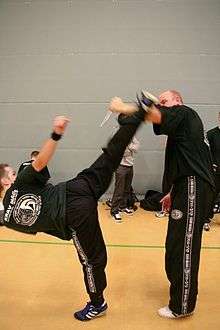 Krav Maga training | |
| Focus | Hybrid |
|---|---|
| Country of origin |
|
| Creator | Imi Lichtenfeld |
| Parenthood | Boxing, Aikido, Wrestling, Judo, KAPAP |
| Olympic sport | No |
Krav Maga (/krɑːv məˈɡɑː/; Hebrew: קְרַב מַגָּע [ˈkʁav maˈɡa], lit. "contact-combat") is a self-defense system developed for the Israel Defense Forces (IDF) that consists of a wide combination of techniques sourced from aikido, judo, boxing and wrestling, along with realistic fight training.[1][2] Krav Maga is known for its focus on real-world situations and its extremely efficient[3][4] and brutal counter-attacks.[5] It was derived from street-fighting skills developed by Hungarian-Israeli martial artist Imi Lichtenfeld, who made use of his training as a boxer and wrestler as a means of defending the Jewish quarter against fascist groups in Bratislava, Czechoslovakia in the mid-to-late 1930s.[6] In the late 1940s, following his migration to Israel, he began to provide lessons on combat training to what was to become the IDF, subsequently going on to develop the system that became known as Krav Maga. It has since been refined for civilian, police and military applications.
Krav Maga has a philosophy emphasizing threat neutralization, simultaneous defensive and offensive maneuvers and aggression.[7] Krav Maga has been used mainly by the Israel Defense Forces' special units and reconnaissance brigades and recently by regular infantry brigades.[8] Closely related variations have been developed and adopted by Israeli law enforcement and intelligence organizations. There are several organizations teaching variations of Krav Maga internationally such as the British SAS and the US Marine Corps.[9][10][11]
Etymology
The name in Hebrew can be translated as "contact combat". The root word krav (קרב) means "combat" and maga (מגע) means "contact".
Basic principles
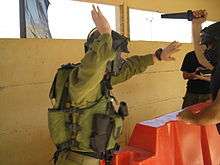
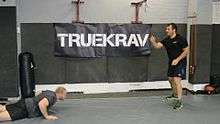
Krav Maga encourages students to avoid confrontation. If this is impossible or unsafe, it promotes finishing a fight as quickly as possible. Attacks are aimed at the most vulnerable parts of the body, and training is not limited to techniques that avoid severe injury; some even permanently injure or cause death to the opponent. Drills provide maximum safety to students by the use of protective equipment and the use of reasonable force.
Students learn to defend against all variety of attacks and are taught to counter in the quickest and most efficient way.
Ideas in Krav Maga include:[5]
- Counterattacking as soon as possible (or attacking preemptively).
- Targeting attacks to the body's most vulnerable points, such as: the eyes, neck or throat, face, solar plexus, groin, ribs, knee, foot, fingers, liver, etc.
- Maximum effectiveness and efficiency in order to neutralize the opponent as quickly as possible.
- Simultaneous attack and defense
- Maintaining awareness of surroundings while dealing with the threat in order to look for escape routes, further attackers, objects that could be used to defend or help attack, and so on.
Training can also cover the study and development of situational awareness to develop an understanding of one's surroundings, learning to understand the psychology of a street confrontation, and identifying potential threats before an attack occurs. It may also cover ways to deal with physical and verbal methods to avoid violence whenever possible. It also teaches mental toughness, using controlled scenarios to strengthen mental fortitude in order for students to control the impulse and not do something rash, instead, attack only when it necessary and as a last result.
History
Imre Lichtenfeld (also known as Imi Sde-Or) was born in 1910 in Budapest, Hungary and grew up in Bratislava (Slovakia). Lichtenfeld became active in a wide range of sports, including gymnastics, wrestling, and boxing. In 1928, Lichtenfeld won the Slovak Youth Wrestling Championship, and in 1929 the adult championship (light and middle weight divisions). That same year, he also won the national boxing championship and an international gymnastics championship. During the ensuing decade, Imi's athletic activities focused mainly on wrestling, both as a contestant and a trainer.

In the mid-1930s, anti-Semitic riots began to threaten the Jews of Bratislava, Czechoslovakia. Lichtenfeld became the leader of a group of Jewish boxers and wrestlers who took to the streets to defend Jewish neighborhoods against the growing numbers of national socialist party and anti-Semitic thugs. Lichtenfeld quickly discovered, however, that actual fighting was very different from competition fighting, and although boxing and wrestling were good sports, they were not always practical for the aggressive and brutal nature of street combat. It was then that he started to re-evaluate his ideas about fighting and started developing the skills and techniques that would eventually become Krav Maga. Having become a thorn in the side of the equally anti-Semitic local authorities, Lichtenfeld left his home, with his family and friends in 1940; on the last refugee ship to escape Europe.
After making his way to Israel, Lichtenfeld joined Israel’s pre-state Haganah paramilitary organization to protect Jewish refugees from Arabs. In 1944 Lichtenfeld began training fighters in his areas of expertise: physical fitness, swimming, wrestling, use of the knife, and defence against knife attacks. During this period, Lichtenfeld trained several elite units of the Haganah including Palmach (striking force of the Haganah and forerunner of the special units of the Israel Defense Forces) and the Pal-Yam, as well as groups of police officers.
In 1948, when the State of Israel was founded and the IDF was formed, Lichtenfeld became Chief Instructor for Physical Fitness and Krav Maga at the IDF School of Combat Fitness. He served in the IDF for about 20 years, during which time he developed and refined his unique method for self-defense and hand-to-hand combat. Self-defense was not a new concept, since nearly all martial arts had developed some form of defensive techniques in their quest for tournament or sport dominance. However, self-defense was based strictly upon the scientific and dynamic principles of the human body. In 1965 judo training was added as part of the Krav Maga training, and until 1968 there were no grades in Krav Maga. Then a trainee's grades were determined largely by his knowledge in judo.[12]
In 1968 Eli Avikzar, Imi's principal student and first black belt, began learning aikido and in 1971 left for France where he received a brown belt in aikido. Upon his return, Eli started working as an instructor alongside Imi where they worked together to improve Krav Maga by incorporating aikido and counter defenses into Krav Maga. Then in 1974 Imi retired and handed Eli Avikzar the Krav Maga training center in Netanya. Shortly after, in 1976, Eli joined the permanent force of IDF, as head of the Krav Maga section. The role of Krav Maga in the army advanced greatly after Eli's appointment. More courses were given and every P.E. instructor was obliged to learn Krav Maga. Eli continued to develop Krav Maga within the IDF until his retirement in 1987. Up to this date, Eli had trained 80,000 male soldiers and 12,000 female soldiers.[12]
Further pursuing excellence as a student of martial arts, Eli went to Germany in 1977 and received a black belt in aikido from the European Federation.[12][13] Then in 1978 the Krav Maga association was established, and in 1989, as an active member of the judo association, Eli Avikzar helped to establish the professional and rank committees by founding the KIsraeli Krav Maga Association (IKMA or KAMI).[12] Eli retired as the Chief Krav Maga instructor in 1987 and Boaz Aviram became the third person to hold the position, being the last head instructor to have studied directly with both Lichtenfeld and Avikzar.[14][15]
Krav Maga in the Israeli government
The IDF Krav Maga instructor course is five weeks long.[16]
Competition
The IDF has had an annual Krav Maga competition since May 2013.[17] Some Krav Maga organizations do not support a competition component, taking the stance that Krav Maga is not a sport. So-called "fighting" sports tend to operate under principles of using safe techniques, doing minimal harm, and consequently wearing down opponents and using other tactics supported by the "rules" of safe competition. In its role as self-defence and as a hand to hand combat system, Krav Maga operates under a completely different set of principles in which techniques may indeed cause significant damage and fights are to be ended as quickly as possible when the conflict cannot be avoided. Krav Maga organizations that involve competition are usually founded and named specifically to focus on using Krav Maga based techniques specifically under a set of sporting principles.
Krav Maga for civilians
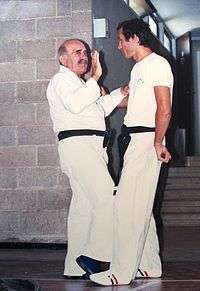
Upon Lichtenfeld's retirement, he decided to open a school and teach krav maga to civilians.[18] The first Krav Maga course took place at the Wingate Institute, Netanya, Israel, in 1971, under the direct supervision of Imi Lichtenfeld.[19] Some of the first students to receive a black belt in Lichtenfeld's civilian Krav Maga Association of 1st Dan, were: Haim Gidon, James Rubenis (UK),Eli Avikzar, Ami Niv krav Maga Aiki, Eyal Yanilov, Richard Douieb, Raphy Elgrissy, Meni Ganis, Haim Zut, Shmuel Kurzviel, Haim Hakani, Shlomo Avisira, Vicktor Bracha, Yaron Lichtenstein, Avner Hazan and Miki Asulin.[20]
In 1978, Lichtenfeld founded the non-profit Israeli Krav Maga Association (IKMA) with several senior instructors. Upon his retirement Imi nominated Haim Gidon as his successor to be Grand Master and the president of the IKMA.[21] Lichtenfeld died in January 1998 in Netanya, Israel.[22]
When Krav Maga started to spread beyond the borders of Israel, there arose a need to found an international civilian organization. A few of Lichtenfeld's first and second generation students, among these being Arviat Zagal, Asaf Halevi, and Dan Levy, eventually formed a new, civilian, international Krav Maga federation.[23]
Grading system
| White | | |
| Yellow | | |
| | ||
| Orange | | |
| | ||
| Green | | |
| | ||
| Blue | | |
| | ||
| Brown | | |
| | ||
| Black | | |
| | ||
| | ||
| | ||
| |
Some of the Krav Maga organizations in Israel, such as the Krav Maga Aiki Ami Niv Federation, IKMA (Israeli Krav Maga Association, by Haim Gidon), KMF (Krav Maga Federation, by Haim Zut) and Bukan (by Yaron Lichtenstein), KAMI (Israeli Krav Magen Association) (by Eli Avikzar),[24] TKM (Traditional Krav Maga by Erez Sharabi), as well as Ultimate Survivor krav Maga International USKMI and international KMW, Alpha Krav Maga, by Sam Sade, Krav Maga Worldwide, by Darren Levine,[25] use Imi Lichtenfeld's original colored belt grading system which is based upon the judo ranking system. It starts with White belt, and then Yellow, Orange, Green, Blue, Brown and Black belts. Black belt students can move up the ranks from 1st to 9th Dan. The time and requirements for advancing have some differences between organizations.
Other organizations that teach Krav Maga in and outside of Israel, like the Krav Maga Aiki Ami Niv Federation, International Krav Maga Federation (IKMF), Krav Maga Global (KMG) and International Krav Maga (IKM), use the same grading system awarding a series of patches.[26] The patch system was developed by Imi Lichtenfeld after the belt system in the late 1980s. The grades are divided into 3 main categories; Practitioner, Graduate and Expert. Each of the categories, which are often abbreviated to their initials, has 5 ranks. Grades P1 through to P5 are the student levels and make up the majority of the Krav Maga community. After P5 are G1-G5, and in order to achieve Graduate level the student has to demonstrate a proficiency in all of the P level techniques before advancing. The majority of instructors hold a G level grade and are civilian instructors. However, passing the instructor's training course is a requirement, and holding a Graduate rank does not necessarily make one an instructor. The Graduate syllabus also builds on the Practitioner syllabus by focusing more on developing fighting skills. The Expert grades cover more advanced military and 3rd party protection techniques as well as advanced sparring and fighting skills. People who hold these ranks tend to teach in other sectors such as military and law enforcement in addition to civilian. In order to progress to Expert level, one has to demonstrate proficiency in all of the Practitioner and Graduate syllabi and have excellent fighting skills. Beyond Expert 5 there is the rank of Master. However, this rank is held by only a small number of individuals and reserved only for those who have dedicated a lifetime to Krav Maga and made valuable contributions in teaching and promoting the style.
Krav Maga organizations in the United States, South America and Europe such as Krav Maga Worldwide, Krav Maga Alliance, National Krav Maga Association (NKMA), Apolaki Krav Maga, United States Krav Maga Association (USKMA), Krav Maga Street Defence, South American Federation of Krav Maga, European Federation of Krav Maga, Hagana System and Krav Maga Academy Slovenia (KMAS, by Karli Zaniug) also use a belt ranking system like that of the IKMA, KMF and Bukan. Although there are some subtle differences, the various organisations teach the same core techniques and principles.[27] Some other organizations such as Pure Krav Maga (founded by Boaz Aviram) and Urban Krav Maga have less formal grading ranks without belts or patches but do have levels by which students can monitor their progress.
Sparring
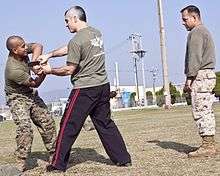
In some organizations like Krav Maga Global (KMG), sparring is slow and light until the student reaches G2 level, which takes approximately 4 to 6 years because climbing from one level to the next in the Practitioner and Graduate levels takes minimum half a year of consistent training (it is however more common to observe regular trainees grading only once a year from P3 and up).[28]
Once in G2, students also do simulated "real" fighting with protective gear.[29]
Some organizations encourage sparring for example International Kapap Association starts from beginner levels and will train full contact with minimal gear in both stand-up and ground-fighting, using semi-professional MMA rules for safety. Sparring should always be supervised and monitored carefully by a qualified instructor.
References
- ↑ "Pure Krav Maga - Self Defense Mastery(TM): Eli Avikzar the Second in Israeli Defense Force Krav Maga Chief Instructor". kravmaganewyork.blogspot.com.
- ↑ "Krav Maga Federation - Israeli Martial Arts and Self-Defense". kravmagainc.com.
- ↑ Levine, Darren; Whitman, John (2009-04-01). Complete Krav Maga: The Ultimate Guide to Over 200 Self-Defense and Combative Techniques. ISBN 9781569751794. Retrieved 2015-04-03.
- ↑ RAJMOHAN, SOORAJ (2013-04-04). "The tactics of Krav Maga". The Hindu. Retrieved 2015-04-03.
- 1 2 Poulomi Banerjee (2009-01-28). "Contact combat: Self-Defence classes to stay safe". The Telegraph. Retrieved 2013-03-05.
- ↑ Hodsdon, Amelia (2005-02-08). "Get your kicks with Israeli tricks". The Guardian. Retrieved 2013-03-05.
- ↑ "All change on the buses". BBC News. 1998-01-15. Retrieved 2013-03-05.
- ↑ "Elite soldiers fight it out in IDF's first-ever Krav Maga tournament". IDF Blog - The Official Blog of the Israel Defense Forces.
- ↑ Jim Wagner and Maj. Avi Nardia. "Inside Israel". Black Belt Magazine. Archived from the original on 2010-05-11. Retrieved 2009-12-31.
- ↑ Judy Ellis (1998-05-04). "Choke! Gouge! Smash!". Time. Retrieved 2010-01-01.
- ↑ Ryan, Rosalind (2002-08-23). "J.Lo's fitness fad and Salma's 'sweaty' hobby". Daily Mail. Retrieved 2013-03-05.
- 1 2 3 4 "וינגייט, המכללה האקדמית - אמנויות לחימה היסטוריה 2". wincol.ac.il.
- ↑ "Israeli Krav Maga vs. Commando Krav Maga". judo-for-self-defense.com.
- ↑ "About Krav Maga". IKMF UK. Retrieved 2013-03-05.
- ↑ "Founder of Krav Maga". krav-maga.com. Retrieved 2013-03-05.
- ↑ "Rare Glimpse into the Ultimate Martial Arts: Krav Maga Instructors' Course - IDF Blog - The Official Blog of the Israel Defense ForcesIDF Blog - The Official Blog of the Israel Defense Forces". IDF Blog - The Official Blog of the Israel Defense Forces.
- ↑ "Elite soldiers fight it out in IDF's first-ever Krav Maga tournament". Israeli Defense Forces. 2013-05-27.
- ↑ Gonzalez Jr., Arturo (1976-11-15). "It's Called 'Kosher Kungfu' but Imi Lichtenfeld's New Martial Art Is a Deadly Affair". People Magazine. Retrieved 2011-10-10.
- ↑ Archived April 8, 2014, at the Wayback Machine.
- ↑ "Emrich Lichtenfeld (sde-or)". K.A.M.I. – Krav Magen History. Retrieved 16 July 2013.
- ↑ "About The Israeli Krav Maga Association". KravMagaIsraeli. Retrieved 2012-05-17.
- ↑ Bob Riha, Jr. (2005-02-24). "Krav Maga teaches practical self-defense in tough workout". USA Today. Retrieved 2013-03-05.
- ↑ "Krav Maga: Self-defence Moves Every Woman Must Know". gympik. Retrieved 25 April 2016.
- ↑ "Eli Avikzar". www.wincol.ac.il.
- ↑ Archived December 24, 2013, at the Wayback Machine.
- ↑ "Grading System". krav-maga.com. Retrieved 2013-03-05.
- ↑ "Home Page". W.A.V.
- ↑ "Krav Maga for Civilians". krav-maga.com.
- ↑ "Fighting Drills G2 -Training Syllabus Sample". Maxkravmaga.com. Retrieved 2015-11-19.
Krav Maga Aiki Ami Niv anti-terror and law enforcement www.Kravs-maga.com / www.kravs-maga.ru
Further reading
- Lo Presti, Gaetano. Krav Maga Borè srl, 2013. ISBN 8891103357 ISBN 9788891103352
- Lo Presti, Gaetano. Imi Lichtenfeld – The Grand Master of Krav Maga Borè srl, 2015. ASIN: B00VXZXG7K
- Imi Sde-Or (founder) and Eyal Yanilov (head instructor) How To Defend Yourself Against Armed Assault, Dekel Publishing house, 2001. This book is the first one published out of the only three books that were written by the founder (Imi) and his closest assistant (Eyal). It has been translated into 10 languages, including: Japanese, Spanish, Czech, Hungarian, German, Dutch, French, Polish and more…
- Aviram, Boaz. Krav Maga: Use of The Human Body as a Weapon; Philosophy and Application of Hand to Hand Fighting Training System. US: Lulu Enterprises, 2009. ISBN 978-0-557-24846-9, ISBN 0-557-24846-9.
- Ben Asher, David. Fighting Fit. The Israeli Defense Forces Guide to Physical Fitness and Self Defense. New York: Perigee Books, 1983. ISBN 0-399-50624-1.
- Cohen, Einat Bar-On. (2011). "Once We Put Our Helmets On, There are No More Friends: The "Fights" Session in the Israeli Army Course for Close-Combat Instructors." Armed Forces & Society 37, No. 3: 512–533.
- Kahn, David. Krav Maga: an essential guide to the renowned method for fitness and self-defence. London: Piatkus, 2005. ISBN 0-01-303950-4.
- Levine, Darren. Complete krav maga: the ultimate guide to over 200 self-defense and combative techniques. Berkeley, Calif.: Ulysses, 2007. ISBN 1-56975-573-6.
- Philippe, Christophe. The essential Krav Maga: self-defense techniques for everyone. Berkeley, Calif.: Blue Snake, 2006. ISBN 1-58394-168-1.
- Master Ofir. HAGANA SYSTEM: Self Protection Academy Founded by Ofir. Paris: Editions Amphora 2012.
- Allan Stevo (2011-06-23). "The Martial Arts / Self-Defense Style Invented in Bratislava". Retrieved 2013-03-05.
External links
-
 Media related to Krav Maga at Wikimedia Commons
Media related to Krav Maga at Wikimedia Commons